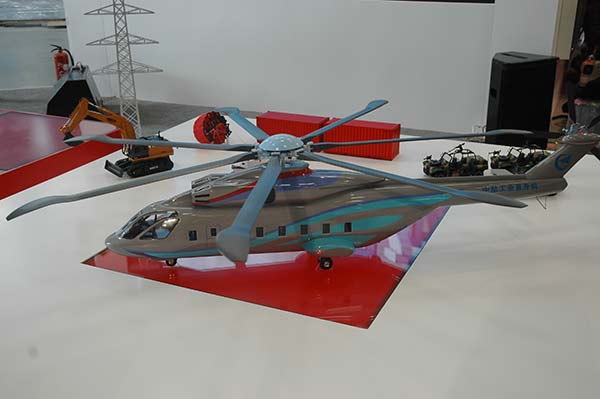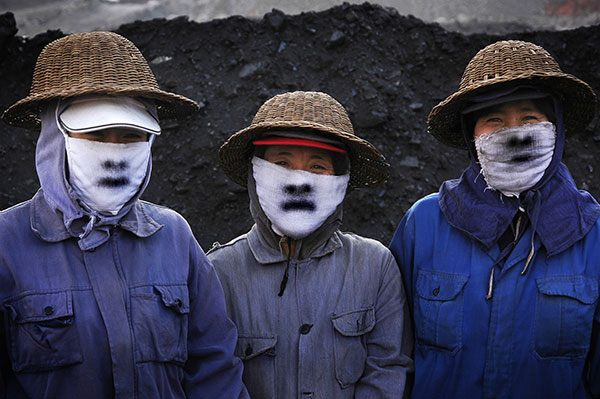China, Russia to co-develop heavy-lift helicopter in 2016
Updated: 2015-09-10 06:52
By Zhao Lei(China Daily)
|
|||||||||||
 |
|
A model of a heavy-lift helicopter is displayed at the Third China Helicopter Expo. [Photo/China Daily] |
Aircraft expected to corner about 25% of international market, industry expert says
China and Russia are close to finalizing an agreement to jointly develop a heavy-lift helicopter next year, according to senior Chinese helicopter designers.
"The project is progressing smoothly, and we are discussing with our Russian counterparts terms and clauses in the agreement. The negotiations should conclude before the end of this year and the development will start next year," said Wu Ximing, chief helicopter designer at Aviation Industry Corp of China, at the Third China Helicopter Expo, which opened on Wednesday in Tianjin.
The new helicopter's production will be based in China, he said, adding it will use the Ukraine-made Lotarev D-136 turboshaft engine at the initial mass-production stage.
"Our existing turboshaft engines' maximum output power is about 1,000 kilowatts, not powerful enough to propel the heavy-lift helicopter. The Chinese engineers are developing a 5,000-kilowatt turboshaft engine that can be used by the aircraft in the future," he said.
Lin Zuoming, AVIC's chairman, said on Tuesday that he expects the helicopter to conduct its first flight around 2020.
Huang Chuanyue, deputy chief engineer at Avicopter, AVIC's helicopter branch, said that China realized in 2008 that it needs a heavy-lift helicopter following a devastating earthquake in Sichuan province. The lack of such aircraft made it very difficult for relief forces to transport urgently needed materials to mountainous areas affected by the disaster, he said.
China then decided to cooperate with Russia, which has experience and know-how in the helicopter industry, to develop a heavy-lift helicopter to serve mainly civilian purposes.
After several years of negotiations, AVIC and Russian Helicopters signed a cooperation framework agreement on the project in Moscow in May.
"The helicopter will use China's world-class avionics systems and advanced materials, while Russia will be responsible for the aerodynamic design, transmission gear and de-icing equipment," Huang said.
According to AVIC, the aircraft will have a maximum takeoff weight of 38.2 metric tons and a maximum cruising speed of 300 km/h. It will be capable of flying at altitudes up to 5,700 meters and have a range of 630 km.
Huang said it will be able to carry 10 tons of cargo, or more than 100 people inside the cabin, or 15 tons in an external sling.
"Compared with Russia's Mil Mi-26, now the largest helicopter used in China, the new aircraft will be more adaptable to plateaus and tropical regions," he said. "This is very important because China has vast plateau areas and mountainous terrain, as well as many islands that are difficult to access by other means. That has been an extremely serious problem because China is often hit by natural disasters."
The aircraft will also be of value for building infrastructure in mountainous terrain and on islands.
Huang said China will need at least 200 heavy-lift helicopters within the coming 30 years, and the international market's demand will reach about 2,000 in that time.
"We expect this helicopter will corner about 25 percent of the international market for this type," he said.
Currently, heavy-lift helicopters in use include the United States' Boeing CH-47 Chinook, Sikorsky CH-53E Super Stallion and Russia's Mil Mi-26 series. The US and Russia continue to upgrade these types and aspire to maintain their joint dominance of the heavy-lift helicopter market, observers said.
Related Stories
Helicopter fleets to double 2015-09-09 06:54
Shanghai grounds helicopter trips after complaints over noise 2015-05-07 07:37
Helicopter replica on the road 2015-04-22 11:29
Pilot dead after helicopter crash in SW China 2015-04-13 19:47
Today's Top News
Queen Elizabeth 'never aspired' to become UK's longest-reigning monarch
Rolls-Royce aims to widen appeal with new convertible
'FX forwards measure is not capital control'
Queen Elizabeth II surpasses Queen Victoria's long reign
China aims to be first to land on far side of moon
Renowned scroll painting unrolled at the Palace Museum
Chinese premier Li commends nation's teachers
China celebrates 50th anniversary of Tibet
Hot Topics
Lunar probe , China growth forecasts, Emission rules get tougher, China seen through 'colored lens', International board,
Editor's Picks

|

|

|

|

|

|






